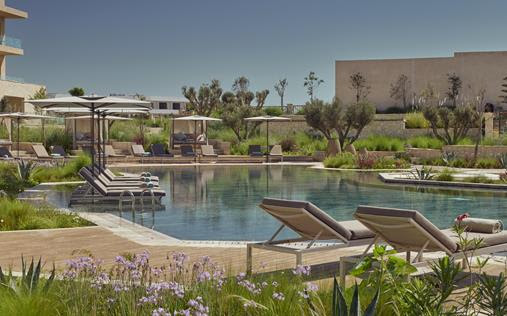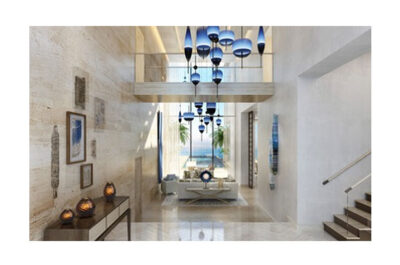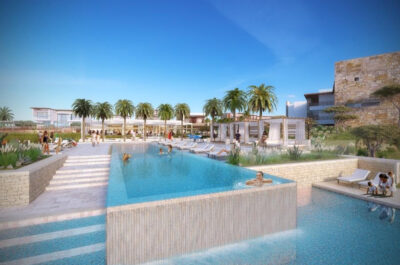A landscape inspired by Berber Journeys in Nature.
Fairmont Taghazout Bay, on the Atlantic coast of Morocco near Agadir, has recently opened featuring a naturalistic and biodiversity rich resort landscape by the award-winning London-based practice, Scape Design. The outcome of a project which began for Scape some 10 years ago with a significant masterplanning exercise for the bay itself, the Fairmont resort offers a narrative that emerges from the natural world of its location as well as from the way of life of the indigenous Imazighen Berbers who once inhabited the nearby foothills of the Atlas Mountains.
The layout of the resort is inspired by the journeys of the semi-nomadic Berbers as they travelled along ancient routes between mountains and sea, following wadis and riverbeds. Often dried-up in this arid region, the wadis are interspersed with astonishing oases where tumbled river pebbles come together with wildflowers and palm trees.
“We worked hard to give the resort’s masterplan the spirit of these places with “wadis” snaking through the site from the entrance down to the beachfront creating circulation routes, numerous vantage points and areas of green planting and shade. Always mindful the effects of climate change on our work, the guest experience is intrinsically, yet subtly, linked to the cultural history and changing geography of the area,” says Philip Jaffa, Founder of Scape Design. “This is very different from the typical hotel or resort plan in Morocco which gravitates around courtyards. The client and the project team were driven to create something that spoke of the location and its rich history steeped in man’s deep connection with nature.”
Another key objective for the team was to minimise the visual impact of the buildings and the structural fill, while at the same time ensuring that each of the 146 guestrooms, suites and villas, as well as the restaurants, all had picture-perfect views towards the Atlantic Ocean and the sunset to the West.
Reinforcing the geographical vision, dry channels framed with verdant grasses and succulents wind their way from the resort entrance through terraced resort hillside and soften as the topography eases to meet the beach front. They articulate spaces, drawing guests to carefully positioned vantage points and opening onto lush plateaus where swimming pools, restaurants and bars are revealed. Water is used sparingly to add drama to key locations and to create unexpected moments along the journey. Where there are water pools, Scape took its cue from desert blooms in the mountains using fragrant native and long-flowering species. As the ocean breeze comes in, the grasses and flowers sway in the wind in contrast to the motionless succulents, echoing the fundamentals of the concept. There are areas of high intervention and design which have strong impact and other areas that feel as if they have happened by chance.
A walled arrival court shaded with date palms and olive trees heralds “you are here”, where the sound of splashing water gently cools the space. As guests walk into the lobby, they are greeted with six-metre-high floor to ceiling glass panels, revealing the panoramic view over the resort to the ocean beyond.
Walls and enclosures are used to screen and guide guests through the informal landscapes and build anticipation until a sliver of light allows a glimpsed view through into another carefully crafted space or breaks open into a new landscape framing views beyond. Concealment and subsequent reveal of exceptional views are seen in nature and used in the most ancient of Morocco’s landscapes. Although Fairmont Taghazout Bay is a thoroughly modern destination, age-old design principles and delicate touches of Berber culture have been woven throughout, crafted to provide areas of tranquillity nestled amongst olive and almond groves where the guest
Each of Fairmont Taghazout Bay’s restaurants offer a distinctive experience, whether that is relaxing on the arrival terraces taking tea, poolside family dining, the floating pavilions of the main restaurant overlooking the extensive grounds, or panoramic views from the speciality restaurant positioned atop a landscaped promontory at the very heart of the resort. The resort also offers a well-equipped conference centre and ballroom, with arrival through a series of walled, arid garden rooms that frame glimpsed views and create shaded break-out seating.
The sunken oasis of the spa garden is indeed a special destination, nestled into a quiet corner and informed by the rustic charm of the quaint Berber villages that are set within hillsides and scattered throughout the eastern Atlas Mountains. Each treatment building is accessed through its own private garden with lush bougainvillea and aromatic rosemary trailing over the earthen-clad walls that surround it.
“The architectural and landscape features influence the site equally, thus creating a natural rhythm with many opportunities for discovery,” adds Philip Jaffa. “The result is a very romantic feel, one which is contemporary and luxurious but, at the same time, uniquely anchored in sense of place connected to nature and the surrounding natural environment.”
Architects on Fairmont Taghazout Bay were HKS Architects, London and Asamad Achari; the interior designers were Wimberly, London.
Vicky is the co-founder of TravelDailyNews Media Network where she is the Editor-in Chief. She is also responsible for the daily operation and the financial policy. She holds a Bachelor's degree in Tourism Business Administration from the Technical University of Athens and a Master in Business Administration (MBA) from the University of Wales.
She has many years of both academic and industrial experience within the travel industry. She has written/edited numerous articles in various tourism magazines.







































































































































































































